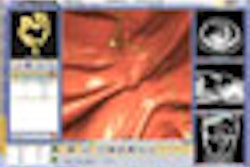ORLANDO, FL - Multidetector-row CT (MDCT) appears to be a good way of determining long-term prognosis in patients with chest pain, researchers stated. They presented the findings in a poster session at the American Heart Association (AHA) Scientific Sessions 2007.
Current diagnostic guidelines call for invasive techniques such as coronary angiography for clinical evaluation of suspected coronary artery disease, but that may one day change, investigators said.
"We may see the implementation of this method within the clinical guidelines within the next five years. Therefore, it's very necessary that we have follow-up data with these tools and present our data," explained Dr. Peter Steinbigler, the study's principal investigator, from Medical Hospital, University of Munich in Germany.
For this study, Steinbigler and his colleagues enrolled 1,107 consecutive patients and performed noninvasive coronary angiography on them utilizing four- to 64-detector-row MDCT angiography (including Brilliance, Philips Medical Systems, Andover, MA), retrospective ECG gating, 0.625-mm collimation, and 0.4-sec gantry rotation time).
Of the patient population, 240 were diagnosed with coronary artery disease and were referred to MDCT, the researchers reported. However, they excluded patients with acute coronary syndromes, stents, atrial fibrillation, and calcium scores greater than 1,500.
The team utilized MDCT angiography results to determine whether patients needed an invasive study. For follow-up data, the team contacted either the patients or the referring physician via mail or telephone at least six months after the scans were completed.
Steinbigler's team obtained diagnostic image quality on 992 of 1,017 patients. The group found that coronary artery stenosis could be excluded with no recommendation for invasive study in 63% (620/992) of the patients.
However, the team noted that 126 patients went on to receive an invasive study due to other clinical indications (83 angiography studies were performed within 30 days of CTA, and 43 more than 30 days following the scan).
Additionally, the researchers found stenoses greater than 50% in only 13 patients, with treatment being unnecessary.
The follow-up period lasted for more than 600 days, with 372 of 992 patients being recommended for invasive coronary angiography and 230 actually going on to have the procedure performed. Among these patients, Steinbigler reported that 165 of the 230 had stenoses of greater than 50% and were subsequently treated with angioplasty or stents.
Investigators stated that MDCT appears to be beneficial in examining long-term prognosis in this patient population, but emphasized that more research will be required.
"The take-home message is easy. If you don't have coronary artery disease at all -- no plaques within the follow up of 600 days -- then we don't find patients who have cardiac events," concluded Steinbigler.
By Jerry Ingram
AuntMinnie.com contributing writer
November 5, 2007
Related Reading
Coronary CTA aids some asymptomatic patients, August 27, 2007
Coronary CTA much improved with newer scanners, August 15, 2007
Coronary CTA results correlate with all-cause mortality, June 19, 2007
Dual-source coronary CTA images the calcium-burdened, April 13, 2007
Copyright © 2007 AuntMinnie.com



















